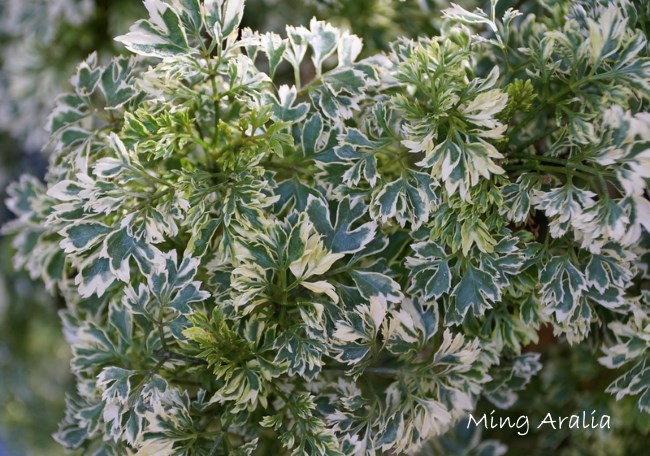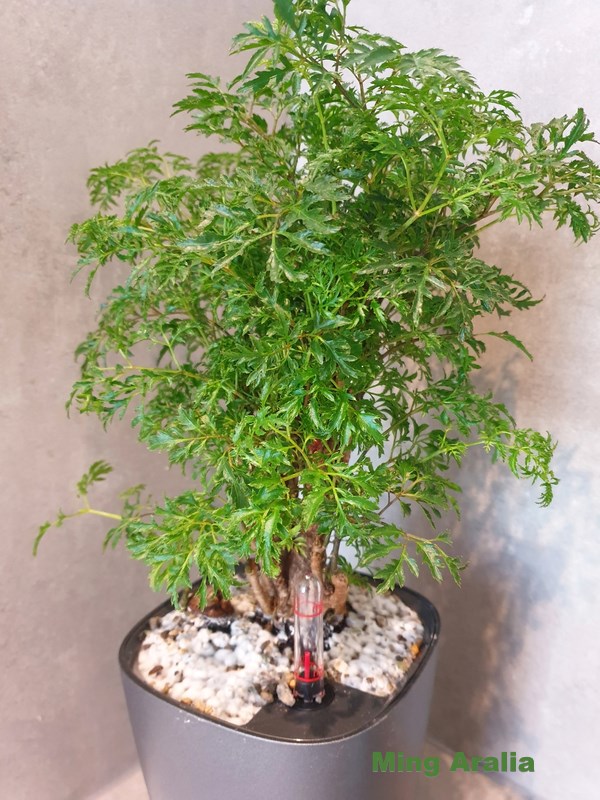Ming Aralia
Ming Aralia only looks fussy. Its stems carry compound leaves made up of several leaflets, giving the fancy, finely cut foliage an elegant quality you'd expect from a high-maintenance plant.
Fortunately for us, this tropical native is extremely adaptable to most homes.
Put it in full sun -- or indirect light. It's quite happy just about anywhere. Keep this aralia plant warm, though. It doesn't like cold temperatures at all. (Who can blame it?)
 Polyscias fruticosa 'Snowflake' has beautiful variegated foliage. Photo © Khairil Junos
Polyscias fruticosa 'Snowflake' has beautiful variegated foliage. Photo © Khairil JunosGet to Know Your Houseplant
Known botanically as Polyscias fruticosa, Ming Aralias are woody shrubs that are native to the warm climates of the Pacific Islands and Southeast Asia. Happily, they adapt quite well to living indoors. One thing they'll want, though, is higher humidity than is usually found in a home. But you won't mind raising the humidity for this handsome houseplant...right?
Polyscias species produce tiny, green, umbrella-like flowers with 4 to 8 segments, when grown in their natural habitat. Will it bloom indoors? I wouldn't count on it. Polyscias rarely blooms when grown as a houseplant. The flowers are insignificant, anyway, compared to the captivating foliage.
Ming Aralia Care
Prune. Ming Aralia has an upright habit and won't grow very tall. Over time, it will drop its lower leaves, revealing a gnarled tree-like trunk. If you want, you can keep it short and shrubby by cutting it back every spring. You'll make it even more beautiful with regular pruning. Prune off the growing tips to encourage branching and denser foliage. Trimming Ming Aralia bonsai plant will keep it at 1 ft (30 cm) or less.
Repot in spring only when it has outgrown its pot. Use the smallest pot that will hold its roots -- aralias grow best when their roots are confined. Pot taller plants in a heavy container to prevent toppling. Mings are easily killed by overwatering, so use a pot with a drainage hole.
Leaf drop. If your Ming suddenly starts shedding leaves, don't panic. Some leaf drop is normal. Is it growing new leaves at the stem tips? If so, this is just part of the normal growth. A sudden change in light, such as moving your plant to a shadier location, may cause leaf drop. Give it as much light as you can. Raising the humidity around it can help, too.
Problems with Ming Aralia are few. It even seems to shrug off pests. Keep this tropical native warm and don't overwater -- and you'll enjoy it for many years.
If you're looking for a captivating floor plant, give Ming Aralia a try. But be warned, this easy-care house plant just may spoil you for anything else.
Buying Tips
You'll find Ming aralia for sale by its common name, although other types of aralia plants are sometimes labeled with the same name. Look for the botanical name Polyscias fruticosa to be sure you're getting this plant.
'Variegata' and 'Snowflake' are much sought-after cultivars, with leaves beautifully edged in white.
It's well-worth seeking. With good care, this aralia is a long-lived plant and a lush, graceful accent for your home.
 Warmth, humidity and sunlight will keep Ming Aralia healthy. Photo ©Wirestock
Warmth, humidity and sunlight will keep Ming Aralia healthy. Photo ©WirestockGrowing Tips for Ming Aralia
Origin: Pacific Islands and Southeast Asia
Height: Up to 3 ft (90 cm); can be grown as a bonsai tree.
Light: Aim for bright light, though it will tolerate varying levels from low light to full sun.
Water: Water thoroughly and allow top 2 in (5 cm) of soil to dry out between waterings. Overwatering is a sure way to kill it. Mings have fine roots and are prone to root rot so when in doubt, keep it on the dry side. Also cut back on water in the winter when growth has slowed.
Humidity: Ming Aralia prefers relative humidity above 50%. Indoor humidity can drop drastically in the winter months without our noticing it. Use a humidity gauge near your houseplant, rather than guess. Leaves will become dry and crispy in dry air. Use a cool-mist room humidifier to boost the humidity around your plant.
Temperature: Average room temperatures 65-85°F/18-29°C. It can take warmer temperatures, but don't expose it to anything below 60°F/16°C. This Polynesian beauty doesn't like the cold at all. It's a good idea to keep it away from heat/AC vents.
Soil: Peat moss-based potting mix with perlite added for good drainage.
Fertilizer: Feed monthly spring through fall with a balanced liquid (or water-soluble) fertilizer (such as 10-10-10) diluted by half. Young leaves that are yellowish-green are caused by a lack of nutrients.
Propagation: Take 4 in (10 cm) stem tip cuttings in late spring or summer. Cut just below a leaf node (the place where the leaf attaches to the stem) and remove the lower leaves from the cutting. For best results, dip cut end in hormone rooting powder before inserting in moist potting mix. Cover with a plastic bag to hold in the humidity. Keep as warm as possible and out of direct sunlight. Bottom heat from a seedling heat mat will keep the cuttings at an ideal 70°F/21°C. Ming Aralia can take a few weeks to root, so be patient.


